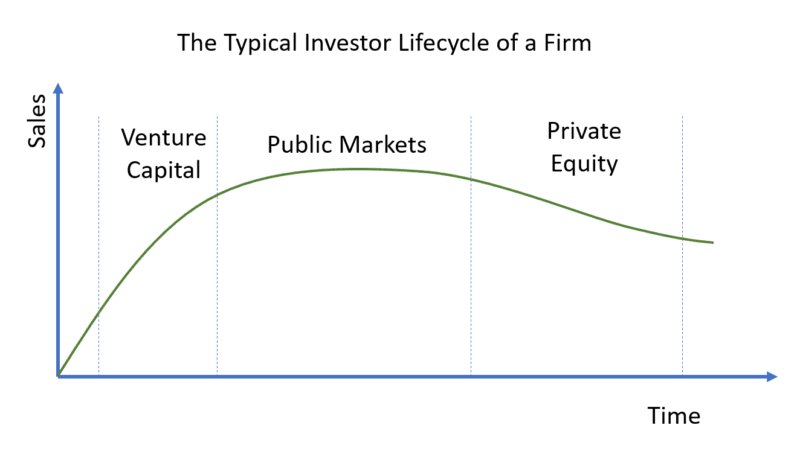Although data is ubiquitous, only those who know how to use it properly will reap its benefits. In this article, we show how Venture Capital and Private Equity investors can be more accountable in their investments through the use of dynamic, long-term Marketing Mix Modeling.
2019 illuminated serious shortcomings in the investment strategies being pursued by both Private Equity (PE) and Venture Capital (VC) investors. At the beginning of 2019, the volume of American IPOs – with the anticipation of massive returns – soared to the highest level since the 2000 dotcom bubble. At the same time, the world of Private Equity had been attracting serious investments with even Warren Buffet himself coming forth as a significant backer to 3G capital.
The markets were off to a strong start. However, things did not go as planned…
The stock market debuts happened, but the flow of returns did not. The initial investor pitch of revenue growth at the expense of profitability was simply not believed by the markets. Thus, the highly anticipated IPO’s, one after another, tanked in market value immediately after listing. Meanwhile, the lauded private equity strategy of ‘Buy, Squeeze, Repeat’, pursued by 3G Capital and Kraft-Heinz, failed spectacularly when it tanked 35% in the first quarter of 2019. This was triggered by a brand evaluation write-off of $16bn that reflected the significant deterioration in brand value created by the gutting of all demand generating investments.
These timely examples reveal weaknesses in both the short-term strategies of VC ‘growth at all costs’ and PE ‘cost squeezing’. Namely, they fail to focus on long-term, sustainable profitability.


We believe that VC and PE investor groups must amend their strategies to be more accountable and either build or rebuild companies with long-term, sustainable profit in mind. Such accountability can only be securely fashioned using the best available data in a strategic way that analytically connects the dots between dollars spent and Return on Investment (ROI). Although data is ubiquitous, only those who know how to use it properly will reap its benefits.
In Private Equity, this strategy will help investors to make cost cuts that do not negatively impact long-term growth and profitability. It might also encourage them to invest in the business to drive greater top-line growth. For Venture Capitalists, these analytical insights will allow investors to identify the prudent levels of investment needed to build sustained demand with a clear path towards long-term profitability.
Can these investor groups learn from companies that have used sophisticated data and analytics to more deeply understand what drives the demand of their consumers? Such companies (identified below as Public Companies) are typically in a more mature stage of growth versus the early stage VC or late stage PE.


The standard approach for more mature, publicly listed companies looking to measure the drivers of demand generation is an ROI analysis such as Marketing Mix Modeling (MMM). MMM is a tool for such businesses to understand the effectiveness of a marketing campaign in terms of its contribution to sales. The results of such an analysis can be used to inform and adjust marketing strategies, optimize budget plans through what-if scenarios, and predict sales. It is one of the most effective ways to responsibly drive growth and profit.
In a recent survey conducted by BCG and Facebook, 90% of mature companies said they leverage a mix of modeling methodologies, inclusive of Marketing Mix Modeling (MMM). However, in our experience the number of start-ups and mature non-public companies using these analytics is significantly less. Why is that PE and VC-backed companies aren’t using this approach to maximize profit and demand?
We believe VC’s have seen less value from MMM because of its reliance on historical data and its limited ability to model growth: by definition, startups have little marketing history and whatever data there is, is unlikely to be predictive of the future. Similarly, PE investors consider historical data of limited value as they pursue strategies that can have radical change. In both cases, MMM is seen as a short-term only focus.


We certainly understand that traditional MMM can suffer these weaknesses, however using an advanced modeling approach that is anchored in long-term, dynamic time-series analysis can overcome such limitations. At Marketscience, we’ve worked with some of the few investor-backed start-ups that have leveraged data and analytics, and more specifically, these dynamic state space techniques that estimate the growth rates of sales, even with limited data. These models can be highly predictive, thus giving more confidence to the findings. They are also able to include a broader set of business drivers that explain key long-term trends in the business, such as customer and brand perceptions, which are in turn driven by marketing and operations. These trends can be thought of as leading indicators, and although they can often move slowly, once harnessed, can have a sustained positive impact on business results.
The reason why a long-term MMM is a good bet for investors is threefold: its ability to predict both growth and profit, its actionability of insights, and its endorsed methodology, embraced by both marketing and finance leadership. When utilized correctly, this type of MMM can become an investor’s most valued solution to identifying the drivers of demand and optimizing investments, thus moving your business forward.
Reason #1: Reach Your Growth, Profit and Restructuring Goals
If you have questions about how to invest your marketing dollars, and profitable growth or cost control is the mandate, analytics that provide a complete view across all key business drivers can eliminate the guesswork and help you reach your goals. After determining what marketing, sales and operations tactics are most effective, long-term MMM can guide you in optimizing a budget towards the more efficient channels, more lucrative audiences, and best messages or experiences to deliver profitable customer interaction. Furthermore, the analysis can be done at an extremely granular, sub-tactic level, meaning you can drill down into the exact tactic that is generating a fruitful return.
For example, after finding out that digital publishers generate an efficient ROI for your company, you can dig deeper into the specific publisher that outperformes the others. From there you can shift budget strategically among the bucket of digital publishers and work towards an even more effective ROI. Enacting a fact-based optimization such as this will grow your company from both a sales and audience perspective. Providing this type of strategic input is unique to long-term MMM.
On the flip side, these models can identify underperforming or even damaging strategies and programs which can often be pursued when companies focus only on short term results and top line growth. It is well written, for example, that over-promoting and price discounting while driving immediate sales will erode brand value and pricing power, thus reducing long-term profitability. Identifying the costs to cut that can actually increase short and long-term valuations should be a key focus for PE take-overs.
At Marketscience, our MMM work with an e-commerce, VC-backed start-up has shown a significant impact on the business bottom line. The data-driven analysis informed that TV spend on a sporting event should be eliminated, while spend on shorter ads should be increased. The results from implementation were significant: the business experienced a 38% improvement in top-of-funnel KPI’s and a 62% improvement in bottom-of-funnel (closest to revenue) KPI’s.
Reason #2: MMM Acts as The Lynchpin to A Complete Measurement System
MMM’s scale and depth of insight coupled alongside a prescriptive output allows one to make confident decisions on where to allocate budgets to best scale for growth. However, since the model relies on historical data to inform these recommendations, it is only truly predictive within that range of historical data: it can’t predict, for example, what may happen if you were to double your budget or try something entirely new. To that extent it needs to be augmented with an aligned approach to testing and experimentation.
Even in the mature stage of a company’s development, experimentation is a crucial ally to measuring effectiveness as it allows one to test some of the model’s wilder predictions, while also generating more data. In fact, the marriage between test & learn experiments and modeling is a great one since each compensates for the other’s weakness: tests provide data on new programs and investments but can often fail to be read accurately while there are other factors influencing business performance. Conversely, modeling can have a holistic view and therefore provide a better set of controls for reading those experiments.
If your marketing department is planning on running a test on a new channel such as Spotify for example, you will need a sophisticated tool like MMM to accurately measure the channels impact and ROI. Trying to see Spotify’s impact on aggregate sales, without controlling for all other drivers, will never be possible. MMM however can isolate the impact of the channel by controlling for these other factors and therefore show whether this is a smart channel to continue investing in, and how much should be allocated in comparison to other channels.
Finally, long-term MMM can integrate other typical business analytics such as customer segmentation, brand tracking, customer feedback, etc. This data can help structure the modeling setup and provide data inputs for the models themselves. Aligning MMM with these other insights helps to provide a more complete view of ROI and the levers at hand to increase effectiveness of demand generation.
Reason #3: Proven Methodology
Marketing Mix Modeling has been used for decades and has been honed through years of trial and error to reflect a myriad of industries, products, and organizations. As such, it is a respected, proven methodology that is embraced by marketing, sales, technology, and finance leadership alike. Stakeholders and leaders such as CMO, CIO and CFO can relate in tandem to the inputs and actions that the model suggests. MMM works on your business’ bottom line and speaks the same language – primarily through ROI – thus creating a common ground among key decision makers to allows for quick, data-driven decision making. There’s no equation or translation of results needed!
A lot of companies ranging in age from early-stage start-ups to larger, more mature entities aren’t taking advantage of the power of data. When such data is harnessed correctly through dynamic, bespoke analytics, it can be truly transformative. When the mandate is profit – whether it’s achieved through growth or cost efficiency, long-term Marketing Mix Modeling can mean the difference between floating or flailing.
